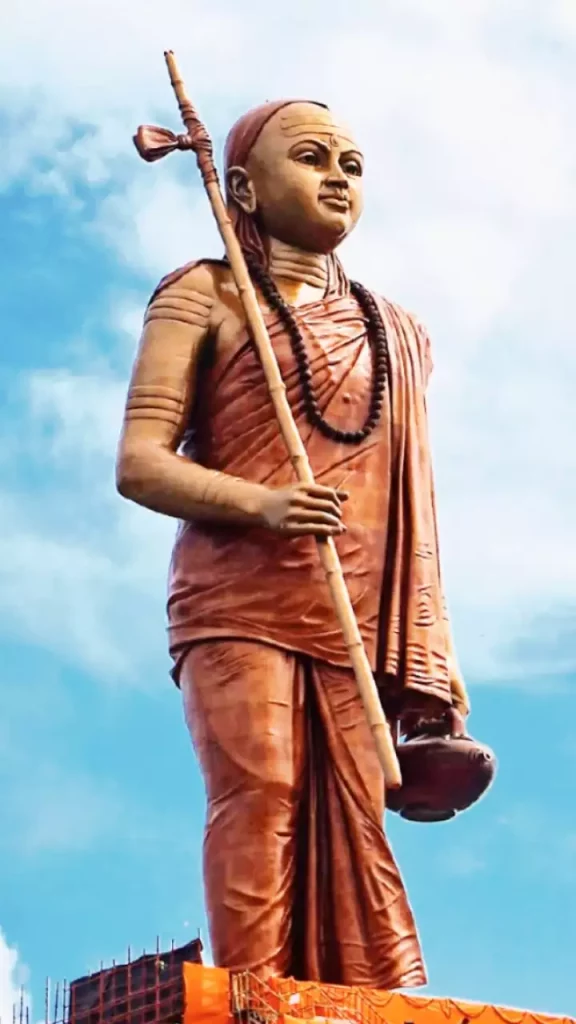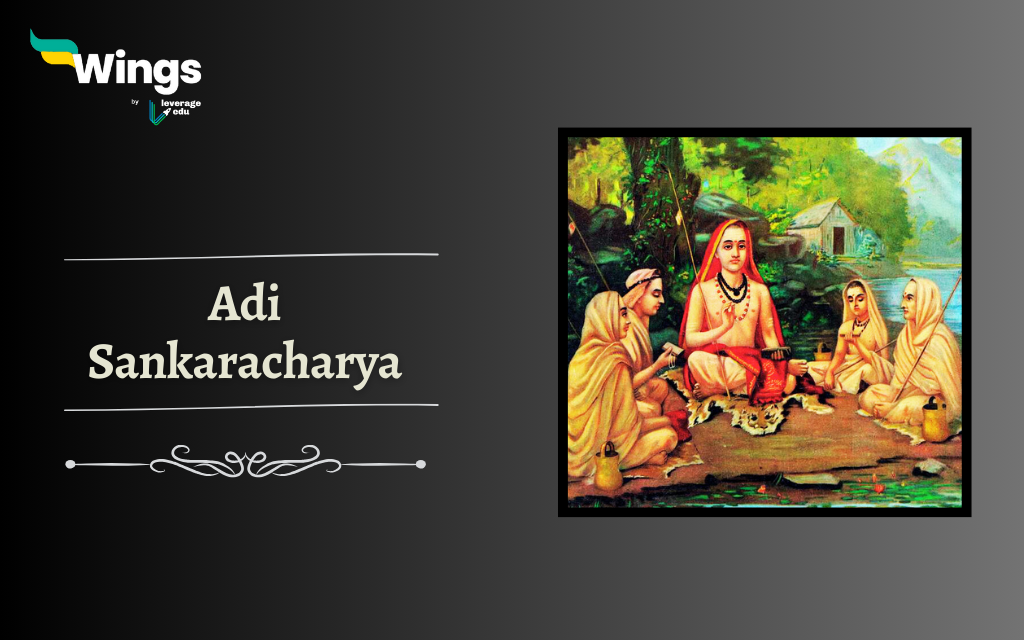Adi Shankaracharya is also known as Shankara Bhagavantpada. He was a revered Indian philosopher and theologian who lived in the 8th century CE. Regarded as the greatest exponent of Advaita Vedanta Philosophy, and was the head of the Sringeri Sharada Peeth. This article delves into the early life, great works and significant contributions of Adi Shankaracharya to the world of spirituality and philosophy.
Contents
Who was Adi Shankaracharya?
Adi Shankaracharya, an influential Indian thinker and spiritual guide from the 8th century, is credited with revitalising Hindu traditions through the philosophy of Advaita Vedanta. He travelled across India, debating scholars and establishing four mathas (monastic centres). His teachings emphasised non-dualism—the belief that the soul and Brahman (ultimate reality) are one. He also composed several important texts and commentaries on the Vedas and Upanishads.
- From a young age, he exhibited remarkable intellectual abilities and immense spiritual inclination.
- He undertook rigorous studies and became a master of various Vedic texts, Upanishads, and other philosophical treatises.
- Shankaracharya’s sharp intellect and devotion led him to embark on a transformative spiritual journey.
- Guru Govindhabhagavath Pada was the teacher of Adi Shankarayacharya.
Early Life of Adi Shankaracharya
Adi Shankaracharya was born in the 8th century CE in a small village called Kalady, located in present-day Kerala, India. His birth was considered a divine blessing to his elderly parents, Shivaguru and Aryamba, after years of prayers and rituals.
Even as a child, Shankara was known for his sharp intellect and deep spiritual inclination. By the age of eight, he had already mastered the Vedas and Upanishads, which even many adults struggle to understand!
His mother played a crucial role in nurturing his curiosity. But from a very young age, Shankara felt a strong pull toward renunciation and self-realisation. One of the most touching stories from his early life is how he convinced his mother to let him become a sannyasi (monk)—a path not commonly allowed for children.
| Detail | Description |
|---|---|
| Birthplace | Kalady, Kerala |
| Parents | Shivaguru and Aryamba |
| Notable Talent | Mastered scriptures by age 8 |
| Spiritual Turning Point | Took monkhood with mother’s blessing |
| Early Education | Vedic teachings under local gurus |
Also Read – Saint Ramanujacharya: Life, Philosophy, Works
Major Journeys and Debates of Adi Shankaracharya
Adi Shankaracharya’s life was marked by intense spiritual travel, intellectual debates, and a mission to restore and unify Hindu philosophy. Here’s how he did it:
Digvijaya Yatra – Spiritual Conquest of India
- Undertook an all-India pilgrimage (Digvijaya Yatra) at a young age.
- Aimed to spread the message of Advaita Vedanta.
- Travelled from Kerala to Kashmir, debating scholars and visiting sacred sites.
- Unified diverse Hindu practices under one philosophical umbrella.
Notable Debates
- Engaged in philosophical debates with scholars of rival schools like Mimamsa, Nyaya, and Buddhism.
- Most famous debate:
- With Mandana Mishra, a Mimamsa philosopher.
- Presided over by Mandana’s wife, Ubhaya Bharati.
- Ended with Mishra accepting Shankara’s views and becoming his disciple.
- These debates were not just intellectual duels but aimed at harmonising conflicting beliefs.
Unifying Hindu Thought
- Refuted extreme ritualism and blind practices prevalent at the time.
- Challenged non-Vedic sects and practices are weakening core Hindu philosophy.
- Advocated non-dualism (Advaita Vedanta) as the spiritual essence of the Vedas.
- Promoted the idea that all deities and paths ultimately lead to one supreme reality – Brahman.
Great Works of Adi Shankaracharya
Adi Shankaracharya integrated some of the essences of Buddhism into the Hindu thought process and accordingly interpreted the ancient Vedic religion.
1. Commentaries on the Prasthanatraya
- Adi Shankaracharya is renowned for his commentaries on the Prasthanatraya, which consists of the Upanishads, the Bhagavad Gita and the Brahma Sutras.
- His commentaries provide various insights and interpretations, unravelling the deeper meanings of these sacred texts.
- These works are considered essential for understanding Advaita Vedanta, emphasizing the non-dualistic nature of reality.
Fun Fact – Brhat-Sankara-Vijaya by Citsukha is the oldest biography of Adi Shankaracharya
2. Advaita Vedanta Philosophy (Non-Dualism)
- Shankaracharya’s most significant contribution is the development and propagation of Advaita Vedanta philosophy.
- Advaita Vedanta asserts the ultimate reality as Brahman, the unchanging and all-pervading existence that transcends the material world.
- Ge believed that God and the created world are one and that the individual soul is not different from the ultimate reality i.e. Brahman.
- In his renowned work, “Brahma Sutras Bhashya,” Shankaracharya provides a comprehensive interpretation of the Brahma Sutras, outlining the principles of Advaita Vedanta.
- Shankaracharya emphasised the concept of “Brahman” as the supreme reality, which is beyond attributes, form, and time.
- He explained that the individual self, known as “Atman,” is identical to the eternal, infinite Brahman and realizing this unity leads to spiritual liberation.
- Shankaracharya expounded on the concept of Maya, the illusion that veils our true nature and stressed the importance of self-realization to overcome this illusion.
3. Establishment of Four Mathas
- Adi Shankaracharya established four Mathas/Mutts (monastic institutions) in different regions of India: 1. Sri Sringeri Sharada Peetha (in the South), Kalika Matha in Dwaraka (in the West), Govardhana Matha in Puri (in the East), and Jyotir Matha in Joshimath (in the North).
- These mathas continue to act as centres of spiritual learning, preserving and disseminating Shankaracharya’s teachings.
- The heads of these mathas, known as Shankaracharyas, are regarded as the successors of Adi Shankaracharya.
4. Revitalisation of Hinduism
- During his time, Hinduism faced challenges and was overshadowed by ritualistic practices and dogmas.
- He believed one can attain Moksha after getting the knowledge of the Vedas.
- Adi Shankaracharya played a pivotal role in revitalizing Hinduism, purifying religious practices and reinstating the supremacy of Vedantic philosophy.
- He was the organiser of the Dashanami Monastic order and unified the Shanmata tradition of worship.
- He implemented reforms, revived Vedic rituals and established ashrams to promote spiritual growth and knowledge.
Also Read – Goswami Tulsidas: Life, Works and Ramacharitmanas
Contribution of Adi Shankaracharya
Adi Shankaracharya’s contributions are not limited to the realm of philosophy and spirituality. He left his mark as a revered religious man. Some of his great works include –
- Undertaking extensive journeys across the Indian subcontinent to restore the prominence of ancient Hindu scriptures and philosophical texts.
- He has authored nearly 116 books which also includes the commentaries.
- He composed commentaries on the major Upanishads, such as the “Mandukya Upanishad,” “Katha Upanishad,” and “Chandogya Upanishad,” providing insights into their deep spiritual meanings.
- Shankaracharya also wrote commentaries on the major Hindu scriptures, including the Bhagavad Gita, the Brahma Sutras, and the ten principal Upanishads.
- His commentaries played a crucial role in preserving and promoting the teachings of these texts, ensuring their continued relevance and understanding.
- Shankaracharya’s influence was instrumental in shaping the bhakti (devotional) movement and the subsequent development of Hindu thought.
- He also emphasised the importance of temple worship as a means to connect with the divine and rejuvenate spiritual fervour among the masses.
- His efforts helped restore the significance and grandeur of temples and ensured their continued reverence and cultural importance.
Fun Fact – In Omkareshwar, a 108 feet tall statue of Adi Shankaracharya is known as the “Statue of Oneness”

Adi Shankaracharya’s contributions to Hindu philosophy, spirituality, and culture remain timeless and invaluable. His teachings and works continue to guide seekers on the path of self-realization and spiritual enlightenment. Through his revitalisation of Advaita Vedanta and his establishment of mathas, Shankaracharya ensured the preservation and propagation of Hinduism’s core principles.
Shankara Jayanti
The birthday of Sri Adi Shankaracharya is celebrated as Shankara Jayanthi. He is regarded as an embodiment of Lord Shiva and the most esteemed Guru (Jagad Guru). He refined the Vedas by imparting discrimination and established the adoration of Deities as the worship of diverse forms of the One God.
It is said in Hindu scriptures that when people began to lose their sense of purity and spirituality, all the gods and goddesses approached Lord Shiva for help in saving the world. Lord Shiva promised to be born as Adi Shankaracharya and encouraged people towards spirituality for the salvation of all living beings. As promised, Lord Shiva was born on earth as Adi Shankaracharya and spread the importance of the Hindu religion to the people. Therefore, the birth anniversary of Adi Shankaracharya is celebrated with great enthusiasm in Hinduism culture.
FAQs
Adi Shankaracharya is primarily famous for his role in reviving and consolidating the Advaita Vedanta philosophy, a non-dualistic school of Hindu thought. He extensively travelled, debated, and wrote commentaries on ancient scriptures, emphasising the oneness of the individual soul (Atman) with the ultimate reality (Brahman).
The “four Shankaracharyas” refer to the heads of the four major monastic institutions (Maths) established by Adi Shankaracharya across India. These are the Peeths of Sringeri, Dwaraka, Puri, and Badrinath, each led by a Jagadguru Shankaracharya upholding Advaita Vedanta.
Adi Shankaracharya was a master debater and is not recorded as being “defeated” in the traditional sense. His philosophical prowess allowed him to establish the supremacy of Advaita Vedanta through rigorous intellectual discourse, converting many opponents to his school of thought.
Adi Shankaracharya established four principal monastic centres (Maths) to preserve and propagate Advaita Vedanta. These are: Govardhan Math in Puri (East), Sringeri Sharada Peetham in Sringeri (South), Dwarka Sharada Peetham in Dwarka (West), and Jyotir Math in Badrinath (North).
The core philosophy of Advaita Vedanta, championed by Adi Shankaracharya, posits that the individual soul (Atman) is identical to the ultimate reality (Brahman). It asserts that the perceived duality of the world is an illusion (Maya), and true liberation comes from realizing this non-dual truth.
Relevant Blogs
That’s all about Adi Shankaracharya! If you want to know more about topics like this, then visit our general knowledge page! Alternatively, you can also read our blog on general knowledge for competitive exams!
 One app for all your study abroad needs
One app for all your study abroad needs














